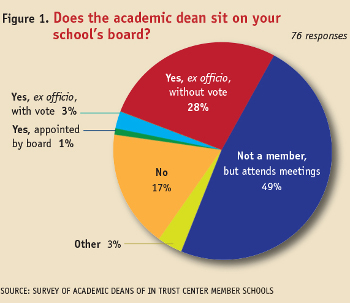Today U.S. institutions of higher education must cope with immense challenges, including fiscal constraints, technological change, and heightened expectations regarding educational outcomes. In Locus of Authority: The Evolution of Faculty Roles in the Governance of Higher Education, William G. Bowen and Eugene M. Tobin argue that patterns of institutional governance in colleges and universities have evolved over the centuries, and that the current structure of governance should be further adapted to meet new demands. Bowen and Tobin zero in on the role of faculty in governance, but always attending to how faculties are situated in webs of relations with other key actors in highly complex systems.
Bowen is president emeritus of the Andrew W. Mellon Foundation and Princeton University; Tobin is senior program officer for higher education and scholarship in the humanities at the Mellon Foundation and president emeritus of Hamilton College. Their book reflects broad historical research as well as interesting case studies on the history of governance at the University of California, Princeton University, Macalester College, and the City University of New York.
The authors review the roles of faculty in U.S. higher education from the colonial period to the present (chapters 2 and 3). They see the U.S. model (with strong lay boards and strong presidents) as a legacy of the colonial context, in which credentialed faculty were few. Through the 19th century — especially with the founding of research universities after the Civil War — the number of faculty members grew, as did their compensation and prestige. By the turn of the 20th century, the contours of the modern university were established, although the resemblance is deceiving: Some prerogatives that faculty now take for granted were absent, as was the concept of academic freedom. The early 20th century saw significant grants of authority to some faculties, with changes often driven by particular local circumstances and the distinct commitments of local leaders.
Sweeping economic and social forces through the 20th century had more widespread impact. Bowen and Tobin discuss how the growing popularity of high school, the postwar economic expansion, and other educational developments affected governance patterns. They describe higher education’s “Golden Age” of the 1960s as a time when, buoyed by the defense industry and economic development, college enrollments ballooned, as did faculty authority and perks. Bowen and Tobin contend that the “euphoria” of the Golden Age “precipitated expectations that have proved to be long lasting — and damaging in key respects” (84).
 |
|
| Locus of Authority: The Evolution of Faculty Roles in the Governance of Higher Education, by William G. Bowen and Eugene M. Tobin (ITHAKA and Princeton University Press, 2015, 400 pp., $30). |
Regarding student protests in the 1960s and 1970s, they reflect on how the economic and cultural role of the university in society makes it “an object of periodic politicization and a symbol for rising expectations and dissatisfaction” (87). Student activists viewed higher educational institutions as both responsible for and morally required to repair social ills. The protests resulted in a broadening of consultative processes in governance at many educational institutions. The pages of Locus of Authority pertaining to the student protest movements and its outcomes for shared governance will repay readers’ careful attention in our present moment of renewed student activism.
The authors chronicle the development of the principle of academic freedom and associated protections, beginning with the 1915 publication by the American Association of University Professors of the Declaration of Principles of Academic Freedom and Academic Tenure. The AAUP wavered in commitment to the cause during the hyperpatriotism of WWI and the Red Scares of the 20th century, but ultimately succeeded in elevating faculties’ role in “managing academic personnel matters related to freedom of utterance and assessments of faculty competence” (44). Bowen and Tobin underscore the necessity of academic freedom for higher educational institutions to fulfill their mission, but also what they see as its appropriate boundaries: academic freedom should not be invoked every time faculties desire a greater part in decision making.
Chapter 4 addresses areas where faculty roles in governance are controversial or evolving: selection and tenure of the president, faculty appointment processes, giving of “advice of all kinds,” decisions about staffing (and the implications of ever-rising numbers of non–tenure-track faculty), maintenance of academic standards, and adoption of new teaching methods (especially online learning programs).
Chapter 5 addresses today’s “overarching challenges” to governance in the face of unrelenting fiscal pressures and cultural and technological transformations.
Bowen and Tobin do not think that faculty are well positioned to make decisions on issues that substantially disrupt the status quo — even if such decisions might strengthen the institution. Nor are faculty acculturated to making such decisions with the “nimbleness” that today’s urgent circumstances often require. Therefore, they argue, decision-making authority on some issues (such as interdepartmental or multicampus program development, or program closure) ought not to be delegated but needs “to be located unambiguously in the hands of senior administrators with campus, university, and sector-wide perspectives — who can be, and should be, held accountable” (207).
The authors approve of the traditional parsing out of some tasks to the different participants in shared governance, but simultaneously insist that ever more precise specification of who owns which issues will not help schools to cope and to thrive. Faculty, presidents, and trustees bring different sorts of expertise and see from different vantage points. Therefore, leaders must embrace a commitment to genuine exchange of perspectives among participants in shared governance and seek opportunities for joint discussion of options, with frank and upfront consideration of costs. On the one hand, faculties must be encouraged to see the larger institutional picture and understand where trade-offs are unavoidable. On the other hand, presidents must engage (or re-engage) in academic matters and seek faculty members’ best wisdom, with genuine openness to being shaped by their perspectives.
Theological institutions today face the same fiscal, technological, and educational-effectiveness challenges (and hence the same need for adaptive change) as colleges and research universities. Without collaborative governance relationships, especially those involving faculty, such adaptation cannot happen: just as in colleges and universities, so also in theological schools faculties have power both to drive and to obstruct needed change. Locus of Authority is relevant for theological school leaders because many theological faculty members’ expectations concerning the locus of authority, distribution of responsibilities, and meaning and value of academic freedom and tenure have been profoundly shaped by the history and forces described in the book.
The call in Locus of Authority for educational leaders to engage in genuine, historically informed, multidirectional consultation and collaboration is very timely. Our era is marked by increasing fragmentation yet deep and intensifying desire for communities that promote dignity, agency, and belonging, and that engage members in service of a common goal. Effective leaders will be skilled at thinking systemically and helping others to do likewise, and at taking seriously the roles and expectations of various players in the system. Those “various players” include faculty to be sure, but also students and employees — all of whom may ascribe more authority and control to the president and administration than what they actually exercise.
Conversation and reciprocal education are surely key to institutional thriving. Patterns of shared governance can and must be reconfigured in ways that are collaborative, not adversarial. Trust and respect given (by all parties and in all directions) will surely be repaid.




























